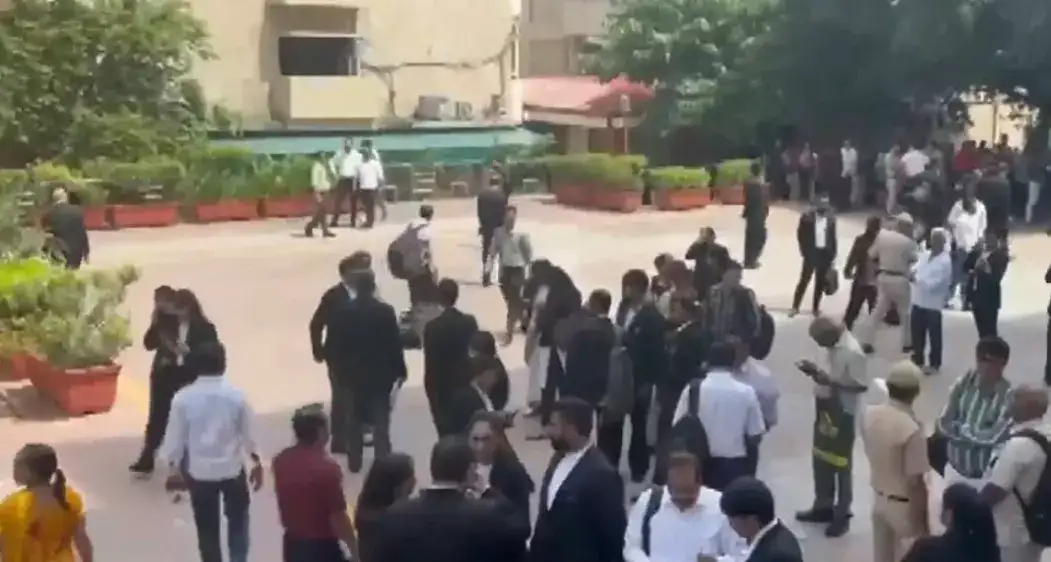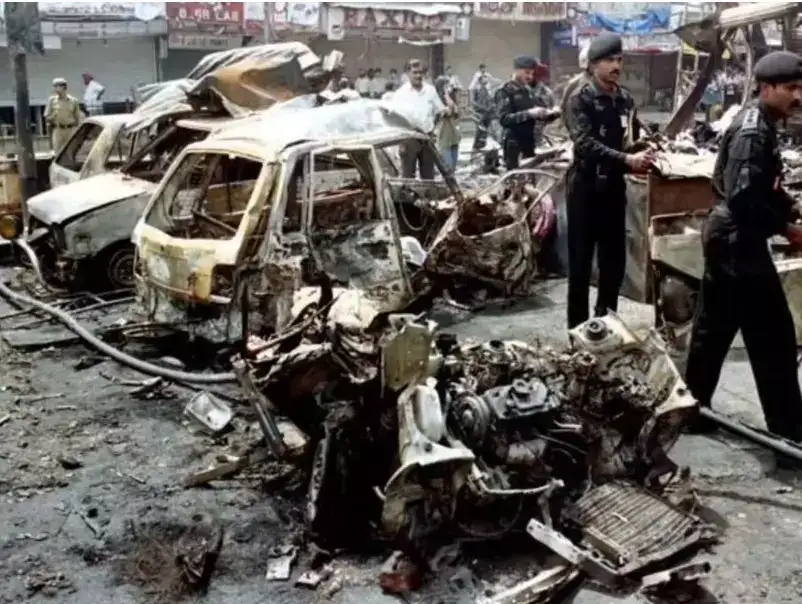Red Fort Blast: A Painful Reminder of Delhi’s Past Explosions - A Look Back at the Tragedies
A powerful explosion near Gate No. 1 of the Red Fort Metro Station jolted Old Delhi around 6:50 pm on Monday, killing at least eight people and injuring more than twenty. The blast, which reportedly originated from a car, sent shockwaves across the historic neighborhood, setting off a fiery chain reaction that gutted six cars, two e-rickshaws, and an autorickshaw.
Eyewitnesses described scenes of panic as flames shot up and glass shattered across the busy lane. “It was a deafening boom, the ground shook,” said a shopkeeper from nearby Chandni Chowk, nearly 800 metres away. Visuals flooding social media showed charred vehicles and thick plumes of smoke clouding the evening sky.
Within minutes, emergency teams reached the spot. Seven fire tenders, forensic experts, and the Delhi Police Special Cell cordoned off the area while the injured were rushed to Lok Nayak Hospital. The National Investigation Agency (NIA) and NSG bomb disposal squads soon joined the probe, combing through debris for chemical traces and explosive fragments.

Preliminary investigations suggest the use of high-grade explosives, though confirmation awaits forensic testing. The intensity of the blast shattered windows of vehicles parked metres away, raising concerns of a coordinated strike.
Adding to the intrigue, the explosion occurred just hours after a major arms and explosives recovery in Faridabad, where authorities seized 360 kg of suspected ammonium nitrate and weapons from a rented flat linked to terror outfits Jaish-e-Mohammed and Ansar Ghazwat-ul-Hind. Officials are now probing possible connections between the two incidents.

Security has been ramped up across Delhi, Noida, Gurugram, and Mumbai, with heavy police presence at Metro stations, markets, and tourist hubs. Forensic teams continue to sweep the blast site late into the night, gathering evidence and reviewing CCTV footage from surrounding cameras.
The Red Fort explosion has once again stirred painful memories of Delhi’s dark past, from the 2005 Diwali-eve blasts and the 2011 Delhi High Court bombing to the 1996 Lajpat Nagar attack. Each of these tragic incidents left an indelible mark on the capital’s collective conscience. Here’s a look back at some of the deadliest terror strikes that have shaken Delhi over the years.
Delhi High Court Blast - September 7, 2011

A powerful briefcase bomb exploded outside Gate No. 5 of the Delhi High Court, killing 15 and injuring 79. The ammonium nitrate and PETN-based device sent shockwaves through the capital. Initially claimed by HuJI and later Indian Mujahideen, the NIA confirmed cross-border links in the attack.

Five near-simultaneous blasts rocked Connaught Place, Karol Bagh, and Greater Kailash, killing 20 and injuring over 90. Hidden in dustbins and shopping bags, the bombs struck Delhi’s busiest spots. Minutes before, an email titled “In the name of Allah” reached media outlets, the Indian Mujahideen claimed responsibility.

A car bomb packed with RDX tore through the crowded Central Market, killing 13 and injuring 38. The Jammu & Kashmir Islamic Front claimed the strike. In 2023, the Supreme Court upheld life terms for four convicts, calling it “a deliberate attempt to destabilize India.”
National Security Advisor Ajit Doval and Home Minister Amit Shah have been briefed. Though the motive remains unclear, officials are treating the incident as a suspected terror act.
Each blast etched pain into Delhi’s memory, but also resilience. From crowded markets to historic monuments, the city has rebuilt, time and again, standing firm against the shadows of terror.

Eyewitnesses described scenes of panic as flames shot up and glass shattered across the busy lane. “It was a deafening boom, the ground shook,” said a shopkeeper from nearby Chandni Chowk, nearly 800 metres away. Visuals flooding social media showed charred vehicles and thick plumes of smoke clouding the evening sky.
Within minutes, emergency teams reached the spot. Seven fire tenders, forensic experts, and the Delhi Police Special Cell cordoned off the area while the injured were rushed to Lok Nayak Hospital. The National Investigation Agency (NIA) and NSG bomb disposal squads soon joined the probe, combing through debris for chemical traces and explosive fragments.

Preliminary investigations suggest the use of high-grade explosives, though confirmation awaits forensic testing. The intensity of the blast shattered windows of vehicles parked metres away, raising concerns of a coordinated strike.
Adding to the intrigue, the explosion occurred just hours after a major arms and explosives recovery in Faridabad, where authorities seized 360 kg of suspected ammonium nitrate and weapons from a rented flat linked to terror outfits Jaish-e-Mohammed and Ansar Ghazwat-ul-Hind. Officials are now probing possible connections between the two incidents.

Security has been ramped up across Delhi, Noida, Gurugram, and Mumbai, with heavy police presence at Metro stations, markets, and tourist hubs. Forensic teams continue to sweep the blast site late into the night, gathering evidence and reviewing CCTV footage from surrounding cameras.
The Red Fort explosion has once again stirred painful memories of Delhi’s dark past, from the 2005 Diwali-eve blasts and the 2011 Delhi High Court bombing to the 1996 Lajpat Nagar attack. Each of these tragic incidents left an indelible mark on the capital’s collective conscience. Here’s a look back at some of the deadliest terror strikes that have shaken Delhi over the years.
Delhi High Court Blast - September 7, 2011

A powerful briefcase bomb exploded outside Gate No. 5 of the Delhi High Court, killing 15 and injuring 79. The ammonium nitrate and PETN-based device sent shockwaves through the capital. Initially claimed by HuJI and later Indian Mujahideen, the NIA confirmed cross-border links in the attack.
Serial Market Blasts - September 13, 2008

Five near-simultaneous blasts rocked Connaught Place, Karol Bagh, and Greater Kailash, killing 20 and injuring over 90. Hidden in dustbins and shopping bags, the bombs struck Delhi’s busiest spots. Minutes before, an email titled “In the name of Allah” reached media outlets, the Indian Mujahideen claimed responsibility.
You may also like
- Faridabad explosives case: Search underway at Al Falah University, many questioned
- Bihar exit polls: Looking back at past predictions across states; how close were they to actual results?
- Trevoh Chalobah likely to replace Marc Guehi in England's squad
- SP Chief Akhilesh Yadav launches 'Vision India' to promote youth-driven, inclusive development
- T20 World Cup-Winning Skipper Wants KKR To Release Andre Russell & Venkatesh Iyer
Diwali-Eve Triple Blasts - October 29, 2005
Two days before Diwali, joy turned into horror as three coordinated explosions ripped through Sarojini Nagar, Paharganj, and a DTC bus in Govindpuri. Sixty-two lives were lost, and over 200 were injured. Investigations traced the strikes to Lashkar-e-Taiba’s front outfit, the Islamic Inquilab Mahaz.Red Fort Attack - December 22, 2000
Late at night, gunmen stormed the Red Fort complex, killing two Army jawans and a civilian. Lashkar-e-Taiba masterminded the assault, targeting one of India’s most iconic monuments. The prime accused, Mohammad Arif alias Ashfaq, was sentenced to death, a verdict upheld by the Supreme Court in 2022.Lajpat Nagar Market Blast - May 21, 1996

A car bomb packed with RDX tore through the crowded Central Market, killing 13 and injuring 38. The Jammu & Kashmir Islamic Front claimed the strike. In 2023, the Supreme Court upheld life terms for four convicts, calling it “a deliberate attempt to destabilize India.”
Early Market Blasts - 1997-1998
Delhi saw a wave of smaller yet deadly explosions, Chandni Chowk (1997) claimed three lives, Punjabi Bagh (1997) four, and ISBT (1998) two. These incidents marked the capital’s first encounters with RDX-based terror devices in urban zones.Red Fort Blast : The Latest Shock
As night falls over Delhi, forensic teams remain at the Red Fort site, collecting chemical samples and CCTV footage. Delhi Police have registered a case under the Explosive Substances Act, while the Union Home Ministry seeks a detailed report.National Security Advisor Ajit Doval and Home Minister Amit Shah have been briefed. Though the motive remains unclear, officials are treating the incident as a suspected terror act.
Each blast etched pain into Delhi’s memory, but also resilience. From crowded markets to historic monuments, the city has rebuilt, time and again, standing firm against the shadows of terror.









